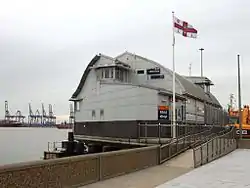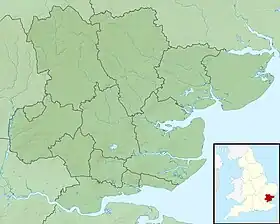| Harwich Lifeboat Station | |
|---|---|
 | |
 Harwich Lifeboat Station. | |
 | |
| General information | |
| Type | RNLI Lifeboat Station |
| Location | Harwich Lifeboat Station, The Quay, Harwich, CO12 3HH |
| Country | England |
| Coordinates | 51°56′55.01″N 1°17′13.56″E / 51.9486139°N 1.2871000°E |
| Owner | Royal National Lifeboat Institution |
Harwich Lifeboat Station is a Royal National Lifeboat Institution (RNLI) station located in the town of Harwich in the English county of Essex.[1] The station is positioned on the southern side at the mouth of the River Orwell estuary. The station serves a particularly busy section of coastline with Harwich being a very busy ferry terminal.[2] Across the estuary is the Port of Felixstowe which is the United Kingdom's busiest container port.[3]
History
1821: first station
The first lifeboat at Harwich was called Braybrooke, and it was first stationed there in 1821.[2] It was named in honour of Richard Griffin, 2nd Baron Braybrooke, Lord Lieutenant of Essex.[4] The lifeboat was financed by the Essex Lifeboat Association, but no funds were available for a boathouse, so the Braybrooke was moored in the harbour. On the Suffolk side of the estuary at Landguard Fort there was a second lifeboat, the Orwell, which was eventually sold and converted to a yacht. The Harwich lifeboat had ceased operations by 1825, and the Braybrooke's fate is unknown.[2]
1875–1917: second station and closure
After the passenger steamship SS Deutschland was wrecked on Kentish Knock on 6 December 1875, it was decided that another lifeboat was needed at Harwich. A new boathouse was built at Timberfields in 1876 and a lifeboat called Springwell arrived in January 1876.[4] The New lifeboat was 35 feet long by 9 feet wide and was self-righting. The Springwell remained at Harwich from 1876 until 1881 and was credited with saving the lives of 61 people, 23 of which had been saved during the launch to the barque Pasithea of Liverpool on 16 February 1883.
In 1889 the RNLI obtained its first steam-powered lifeboat, the Duke of Northumberland (ON 231), which was sent to Harwich in 1890. The station with Springwell became known as Harwich No. 1 station, whilst the mooring near Halfpenny Pier where the Duke of Northumberland was kept afloat became the No. 2 station.[2][4] In 1892, the Duke of Northumberland was sent to New Brighton on Merseyside. It was replaced in 1894 by another steam lifeboat, the City of Glasgow (ON 362).
In 1902 the No. 1 station lifeboat Springwell (ON 317), the second boat to bear that name, was scrapped. In 1904 station No. 1 was given another Watson-class lifeboat, Ann Fawcett (ON 517). In the years leading up to World War I, Harwich was used for the testing of new motor lifeboats which were sent to other stations.[5] In 1912 the Ann Fawcett was withdrawn from service once again leaving the City of Glasgow the only lifeboat on station.[6]
By the breakout of the First World War in 1914, the City of Glasgow (ON 446), the second to bear this name, was the only lifeboat at Harwich. In 1917 the Admiralty commandeered the lifeboat for patrol duties.[6] Harwich Lifeboat Station was closed, leaving the area to be covered by Aldeburgh Lifeboat Station to the north and Walton Lifeboat Station to the south.[7]
1960s–1980: reopening and European Gateway incident
Harwich Lifeboat Station did not reopen until 1965, when increased traffic to the Harwich ferry as well as the Port of Felixstowe across the estuary necessitated more lifeboats in the area. A 16 ft inshore inflatable lifeboat boat was stationed for the summers of 1965 and 1966.[2] In September 1967, a 44 ft Waveney-class lifeboat, Margaret Graham (ON 1004), was sent to Harwich.[2][6] After a successful two-year trial period, the Margaret Graham was made a permanent fixture at Harwich, where she remained until being replaced by the John Fison (ON 1060) in 1980.[6]
The most notable incident attended by a Harwich station lifeboat was the European Gateway incident of 19 December 1982. The roll-on roll-off car ferry European Gateway was leaving Felixstowe for Zeebrugge when it collided with the train ferry Speedlink Vanguard approaching Harwich Harbour. The bow of the Speedlink Vanguard struck the European Gateway amidship, and she quickly capsized to the point where only half the starboard side of the vessel was above the water. Numerous lifeboats and tugs responded to the scene and began rescuing passengers from the European Gateway within minutes. The Speedlink Vanguard launched her own lifeboat to assist. Within an hour all passengers but six had been rescued.[8] By the time the John Fison arrived, all that remained was to search for the bodies. The John Fison recovered two bodies, three others were located by other boats, and one remained unaccounted for.[9]
1997–2003: new station

In 1997, Harwich acquired 17-03 Albert Brown (ON 1202), a Severn-class, fast afloat boat built by Green Marine in 1995.[10] She is 17 meters long, 5.5 meters wide with a depth of 1.38 meters, with a top speed of 25 knots and a range of 250 nautical miles.[11] The Albert Brown was financed with bequest from Victoria Brown to commemorate her husband Albert Brown, and christened by Terry Waite CBE on 25 May 1997.[6]
In 2002, Harwich acquired the Sure and Steadfast (B789), an Atlantic 75-class second generation rigid inflatable boat (RIB).[12] She was named on 18 May 2003 after the motto of the Boys' Brigade in recognition of the fund raising efforts for the RNLI by that organization.[13]
In 2003, funds were secured for a new boathouse and facilities, at a cost of £1.25 million.[14]
On 21 May 2018, the new Atlantic 85-class lifeboat Tierney Harvey & Sonny Reid (B-907) arrived in the town to a warm welcome from crowds and supporters. She was funded by The John & Elizabeth Memorial Trust, which was set up in 1998. [15]
As of 2023, 17-03 Albert Brown and B-907 Tierney Harvey & Sonny Reid are on service at Harwich.[16]
Fleet
Harwich No.1 Station
| ON[lower-alpha 1] | Name | In service [16] | Class | Comments | Photo |
|---|---|---|---|---|---|
| Braybrooke | 1821−1825 | Norfolk and Suffolk-class | |||
| Springwell | 1876−1881 | Self-Righter | |||
| 317 | Springwell II | 1881−1902 | Self-Righter | ||
| 206 | Reserve No.3 | 1890−1891 | |||
| 517 | Ann Fawcett | 1904−1912 | Watson-class | ||
Harwich No.2 Lifeboat Station
| ON | Name | In service [16] | Class | Comments | Photo |
|---|---|---|---|---|---|
| 231 | Duke of Northumberland | 1890−1892 | Harwich-class Steam | ||
| 362 | City of Glasgow | 1894−1897 1898−1901 |
Steam | ||
| 446 | City of Glasgow II | 1901−1917 | Steam | ||
Harwich Lifeboat Station
All-Weather Lifeboats
| ON | Op. No.[lower-alpha 2] | Name | In service [16] | Class | Comments | Photo |
|---|---|---|---|---|---|---|
| 1004 | 44-005 | Margaret Graham | 1967−1980 | Waveney-class | ||
| 1060 | 44-020 | John Fison | 1980−1996 | Waveney-class | ||
| 1202 | 17-03 | Albert Brown [17] | 1996− | Severn-class | ||
Inshore Lifeboats
| Op. No. | Name | In service [16] | Class | Comments | Photo |
|---|---|---|---|---|---|
| D-71 | Unnamed | 1965−1970 | D-class | ||
| D-14 | Unnamed | 1968 | D-class | ||
| D-201 | Unnamed | 1971−1973 | D-class | ||
| D-206 | Unnamed | 1974−1975 | D-class | ||
| D-225 | Unnamed | 1977−1978 | D-class | ||
| B-526 | Unnamed | 1978−1987 | Atlantic 75-class | ||
| B-571 | British Diver II | 1987−2002 | Atlantic 75-class | ||
| B-789 | Sure and Steadfast [13] | 2002−2018 | Atlantic 75-class | ||
| B-907 | Tierney Harvey & Sonny Reid [15] | 2018− | Atlantic 85-class | ||
Geographic location of neighbouring stations
References
- ↑ "Harwich Lifeboat Station". The Official Harwich RNLI website. RNLI web site. Retrieved 18 September 2013.
- 1 2 3 4 5 6 Beilby, Alec (1992). Heroes All!: The Story of the RNLI. Patrick Stephens Ltd. pp. 157–158. ISBN 978-0-85429-866-2 – via Internet Archive.
- ↑ Journal of Commerce: THE JOC TOP 50 WORLD CONTAINER PORTS
- 1 2 3 Wreck and Rescue on the Essex Coast - The wreck and rescue series. Author: Malster, Robert.Publisher: D.B.Barton; First edition. Hardback 168 pages. Edition: October 1968. ISBN 978 0851530000
- ↑ A chronological history of the Fishguard lifeboat at the RNLI website Archived 2012-05-23 at the Wayback Machine retrieved 30 September 2013
- 1 2 3 4 5 "Our Station History | Harwich Lifeboat Station| The Royal National Lifeboat Institution - Saving Lives at Sea". harwichlifeboat.org.uk. Retrieved 28 December 2021.
- ↑ "Harwich's station history". RNLI. Retrieved 2 January 2024.
- ↑ "European Gateway Disaster Memorial Planned". BBC News – Suffolk. BBC © 2013. Retrieved 2 October 2013.
- ↑ Beilby 1992, pp. 158–159.
- ↑ "Lifeboats built like Racehorse's". ProBoat online. Professional BoatBuilder Association, © Copyright 2013, All Rights Reserved. Archived from the original on 4 October 2013. Retrieved 2 October 2013.
- ↑ "Severn -Technical specifications". Lifeboats – Severn Class. Royal National Lifeboat Association, © Copyright 2013, All Rights Reserved. Retrieved 2 October 2013.
- ↑ "Atlantic 75 B-class - Technical specifications". Lifeboats – Atlantic 75 Class. Royal National Lifeboat Association, © Copyright 2013, All Rights Reserved. Retrieved 2 October 2013.
- 1 2 "2000 – Lifeboats". The Boys Brigade. Retrieved 18 May 2003.
- ↑ "Harwich Lifeboat Station". Station Description page. R.N.L.I. at Harwich.org. Retrieved 2 October 2013.
- 1 2 "Harwich RNLI officially names its new B-class lifeboat". RNLI. Retrieved 11 August 2018.
- 1 2 3 4 5 Leonard, Richie; Denton, Tony (2023). Lifeboat Enthusiasts Handbook 2023. Lifeboats Enthusiasts Society.
- ↑ "25 years of saving lives for Harwich RNLI's Albert Brown". RNLI. Retrieved 29 September 2021.